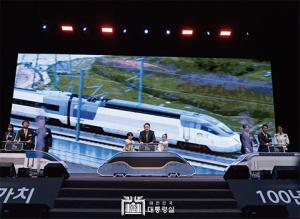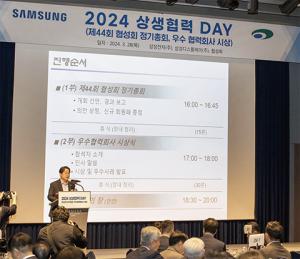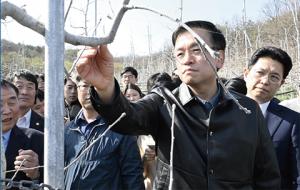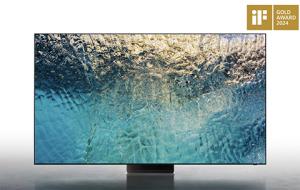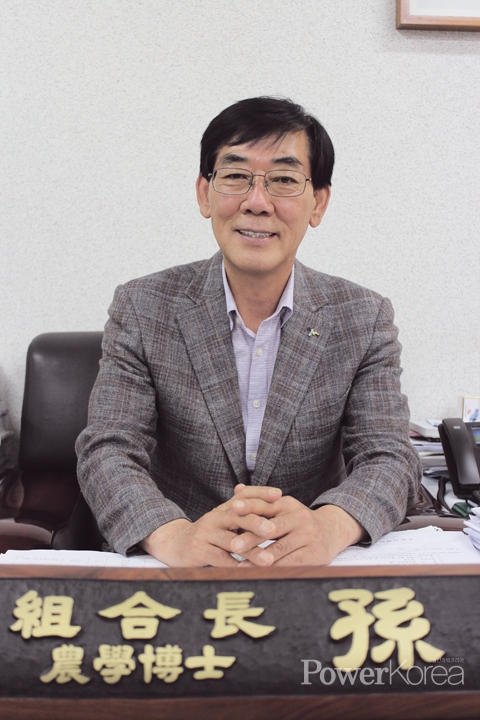 |
| ▲ 포항시산림조합 손병웅 조합장 |
우리 국토의 약 64%를 차지하고 있는 산림은 천연자원의 대부분을 수입에 의존하고 있는 자원빈국인 우리나라가 보유하고 있는 몇 안 되는 소중한 재산이다. 특히, 지구온난화와 대기오염 등 갖가지 환경문제가 심화되고 있는 상황에서 산림생태계의 효과적인 관리와 활용은 우리의 미래를 결정지을 수도 있는 중요한 과제다. 이에 포항시산림조합은 지난 55년여 간 조림, 육림, 숲 가꾸기 등 산림녹화와 사방사업을 중심으로 주어진 역할에 최선을 다해왔다.
선진화된 산림경영 시스템의 새로운 답안을 제시하다
한국사방사업 100주년을 기념하여 2007년 문을 연 ‘사방기념공원’을 가지고 있는 전국에서 유일한 지역인 포항시는 전체 면적의 약 67%가 산림으로 구성된 풍부한 녹지를 자랑하는 도시다. 이는 산지로 둘러싸인 포항의 지형적 특성도 있지만, 지난 1962년 창립되어 포항지역의 건강한 산림자원 육성에 힘써온 포항시산림조합의 역할도 빼놓을 수 없다.
포항시산림조합은 지속가능한 산림경영 시스템의 확산을 촉진하고 산림자원을 통한 소득의 증진은 물론, 약 5,200여 명에 달하는 조합원과 산주 및 임업인들의 경제·사회·문화적 지위 향상, 지역경제의 균형 있는 발전에 기여하고자 앞장서왔다. 특히, 지난해 6월에는 목재 가공 공장을 준공하며 보다 효율적인 목재자원 활용을 위한 인프라를 구축하기도 했다. 2015년 11월, 제19대 조합장으로 취임하여 지금까지 포항시산림조합을 이끌어오고 있는 손병웅 조합장은 “숲은 미래의 생명자원이라 일컬어집니다. 펄프나 용재 등 산림으로부터 생산되는 여러 가지 임산물은 우리 생활 속에서 유용하게 사용되고 있으며, 각종 생물자원의 보고로서, 환경정화 기능과 휴양 및 문화를 즐기는 공간으로서 산림은 무한한 가치를 지니고 있습니다”라고 설명했다. 더욱이 산림자원의 가장 큰 특징인 ‘어떻게 관리하느냐’에 따라 먼 미래에 이르기까지 지속적인 가치창출이 가능하다는 점은 선진화된 산림경영 시스템의 확립이 무엇보다 중요하다는 사실을 반증하고 있다.
이에 손병웅 조합장은 조합 내 모든 임직원들과 합심하여 다방면의 노력을 펼쳐왔다. 먼저 조합 내 관리조직을 정비하고 각종 교육을 통해 인력육성 및 업무 능력 향상에 힘썼으며, 임업 인적자원의 조직화를 기반으로 조합의 역량을 강화하고자 노력해왔다. 또한 조합의 자립기반을 확립하고자 임업의 6차 산업화 및 임산물 생산유통사업의 활성화, 금융사업 안정화 및 장기 수익기반 구축에 심혈을 기울였다. 손 조합장은 “저희는 조합의 신성장 추진동력으로서 대리경영활성화, 목재유통센터 신제품 발굴, 임업관련 공모사업 적극추진 등을 통해 지속적 발전을 도모하고 있으며, 부가가치를 높이기 위한 다양한 사업을 개척하고 있습니다. 뿐만 아니라 조합원의 소득향상을 위한 실질적 도움을 드리기 위해 임업관련 맞춤교육과 산림경영지도, 산지개발 인·허가, 임목벌채대행 등의 민원업무를 제공하고 산림산업인 회관건립과 함께 산림복합타운을 계획하고 있습니다”라고 밝혔다.
창조와 혁신의 자세로 산림산업의 발전과 활성화에 최선 다할 것
산림 자원을 ‘돈 되는 임업’으로 창출하고, 산림산업의 발전을 선도함으로써 조합원과 산주, 임업인으로부터 신뢰받는 조합으로 거듭나고자 하는 이들의 노력은 손병웅 조합장의 다양한 실무능력과 풍부한 경험, 탁월한 전문지식을 바탕으로 시너지 효과를 일으키고 있다. 산림분야의 최신 기술과 아이디어를 융합해 다양한 사업 분야에 적극 반영하고 있는 것은 물론, 유관기관과의 업무연계를 통해 수익구조 개선과 조합원 복지 향상, 임목자원 활용사업의 다양화에도 주목할만한 성과를 거두고 있는 것이다. 이러한 공로를 인정받아 손 조합장은 지난해 ‘2016년 자랑스러운 한국인 대상’을 수상하기도 했다.
지난 6월 30일 창단된 ‘포항시산림산업인연합회’는 산림산업 활성화를 실현하고자 앞장서 온 그간의 노력이 결집된 결과다. 연합회의 초대 회장으로 선임된 손 조합장은 “산림의 공익적 가치에 대해서는 누구나 공감하는 바이지만, 정작 임업인의 소득 수준은 산업별 평균 소득에 크게 못 미치는 어려운 상황입니다. 더구나 농업, 수산업, 축산업 등 타산업에 비하여 열악한 재정적 지원은 물론, 행정적 지원 또한 홀대받고 미미한 가운데 수많은 산림산업인들은 지금껏 산림사업을 이끌어왔다 해도 과언이 아닙니다. 이러한 불균형을 해소하기 위해선 불합리한 각종 제도적 제약의 개선과 함께 원활한 경영을 위한 행정 지원과 관련 지원제도의 신설이 반드시 필요합니다”라고 역설했다. 이에 연합회에서는 임업직불제 및 개발권거래제 도입, 산림재해보험제도 도입, 산지은행제도 도입, 국산재 등 임산물 경쟁력 강화를 위한 지원제도 신설, 청년 산림부문 창업투자 지원제도 신설, 고부가가치 산림비즈니스모델 민간투자 보호제도 신설 및 경쟁력 강화방안 모색 등의 기본법 제정을 요구하고 있다. 또한, 4차 산업혁명 시대에 걸맞은 고부가가치 산림산업 모델을 창출함으로서 포항 지역뿐만 아니라 전국의 수많은 임업인들에게 새 시대의 임업이 나아갈 길을 제시하는 것이 이들의 목표다.
손 조합장은 “포항시산림조합의 조합장으로서, 그리고 포항시산림산업인연합회의 회장으로서 저에게 부여된 역할이 무척이나 크고 막중하다고 생각됩니다. 제게 주어진 소명을 다하는 그날까지 열정과 투지로 산림산업인을 대변하고, 나아가 국가의 성장과 발전에 기여하고자 합니다”라며 포부를 밝혔다. 그리고 이에 덧붙여 앞으로 추진해나갈 여러 사업들이 제 목적을 다할 수 있도록 산림산업인들의 끊임없는 관심과 지원을 당부했다. 우리나라 산림산업의 새로운 미래를 열어나가고자 하는 이들의 열정에 응원의 박수를 보낸다.
Finding the Competitive Edge of 4th Industrial Revolution in ‘Nano Science’
Professor Geunbae Lim of POSTECH Nano&BioMEMS Lab.
World’s first structural coloration technology with low cost and high efficiency
Most colors found in the nature are determined by the object’s own characteristic color. But for some cases, they are determined by physical phenomena such as diffraction or interference of light. These cases include the coloration of peacock tails, patterns found in butterfly wings, and the bluish glow on the beetle shells. We call them ‘structural coloration’.
Although structural coloration is easily found in many cases of nature, it is hard for us humans to replicate the same phenomenon. This is because it takes place in the nanometer scale with extremely small particles and thin films, which cannot be expressed with traditional ink. Of course there has been several attempts at structural coloration, and they were faced with major limitations such as not being able to make changes to the once formed colors and not being able to express various different colors in a single substrate.
Recently, Professor Geunbae Lim and his fellow researchers in Nano&BioMEMS Lab have developed structural coloration technology using nanostructure for the first time in the world. This technology utilizes nano particles that are smaller than the wavelength of visible light, which causes reflection, refraction and diffraction of the incoming light to form structural coloration. Compared to pre-existing methods this technology is capable of mass manufacturing on large scale areas while being economically beneficial. The technology holds promising applicability to various fields including display technology, small electronics, and anti-forgery printing. Professor Geunbae Lim of POSTECH explained, “The structural coloration technology we have developed is capable of expressing various different colors on a single substrate while being able to make changes to the already formed colors. Also, the coloration process is completely compatible with the traditional semiconductor fabrication techniques, and this would allow applications to biochip sensors afterwards”. This work was carried out with GeonHwee Kim (Ph.D. course), and Professor Taechang Ahn of Mechanical Design Engineering at Andong University.
“Excellent scalability of nanotechnology will stand out as a world leading trend”
Professor Geunbae Lim has been working on development of various fabrication techniques of micro/nano scale hardware ever since he became a professor at POSTECH. Most notably, he has put enormous effort in studying unique phenomena that takes place in the nano scale and bringing it to the larger scales where it can be applied to our everyday lives. With the development of nanoscale devices with high reproducibility, such technologies include nanoscale pipetting, biosensor, neural electrode, and nano particle separation. Recently, his team is also working on highly sophisticated surgical tools embedding nanotechnologies mentioned above.
His research team developed an inertia sensor fabricated through MEMS technology, which is now being commercialized through co-working companies. One of their work, ‘Gore-Tex technology through nanocrack formations’ has been published as the main featuring article at one of the highly renowned scientific journals. They have developed a ‘motion rehab sensor’ which is in progress for technology transfer to hospitals and venture businesses. His team also began the R&D step of the original technology of high speed water filter and bio-extractor using electric field.
Professor Geunbae Lim explained, “Nowadays I am interested in research topics that has a great competitive edge only with a little resource and facilities. For instance, the nanowire fabrication technology using electric field greatly surpasses traditional technologies while being considerably cheaper.” This work is currently under commercialization process with research centers and venture companies. He emphasized that this point is the biggest merit of studying nanotechnology: accomplishing what no one has ever succeeded before and acquiring the competitive edge that will lead the 4th industrial revolution.
He insists that his ultimate role as a researcher of science and engineering is to dedicate his abilities to make the world a better place. He believes that it is important to first get recognition by developing a beneficial technology and ultimately pursue practical application and commercialization of the developed technology. Also, he didn’t forget to mention there needs a systematical support and interest from the government. He mentioned, “I feel that the level of our research results and technology is almost on par with those of other advanced countries and I believe our young researchers can show off their capabilities and make world leading research results with the help of the systematical support”. We hope that all the efforts these young researchers are putting into are paid off with world leading technologies and eventually drive Korea to be a leader in the scientific research field.
임승민 기자 press0105@naver.com

